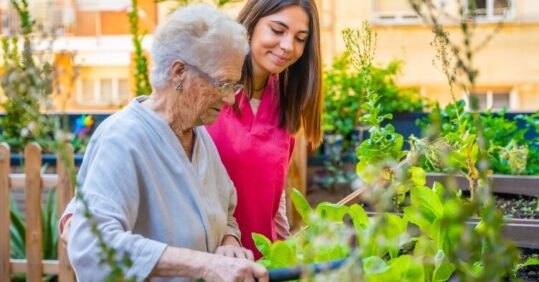Recognise the benefits of intergenerational activities in care homes

It is often said that it is the younger generations that keep older people feeling youthful, so it makes sense that this should be a strategy used in care homes. There are few sights that bring more joy than seeing an elderly person laughing and smiling as a young child shows them a drawing or tells them a joke.
Intergenerational activities in care homes are proving to be essential in benefiting both the residents themselves and the younger generations that are involved. It not only helps to foster connections but can play an active role in reducing issues such as isolation and helping to create a sense of belonging.
Our homes proactively build connections with local schools, nurseries, and youth clubs, encouraging visits into the home where children and residents can enjoy games, reading sessions, and arts and crafts together. These kinds of meaningful interactions help form real connections across generations.
What are intergenerational activities?
An intergenerational activity will involve interactions between older adults and people younger than them within an informal or structured setting. We might think of this as being a combination of the very oldest and very youngest members of society, but it can actually involve people from all sorts of different generations.
These can be brought together in entertaining and fulfilling activities such as singing songs, gardening, reading, and arts and crafts. This means it can go beyond simply entertaining care home residents and become a two-way activity where they are able to share their own knowledge and expertise as well. It can help to form some genuine connections that have a mutual benefit and have consistently shown benefits for everyone involved.
To keep residents engaged, we regularly host family-friendly events, such as summer fetes and fairs, to encourage visits from local residents and children. We also welcome school choirs and dance groups to perform during the holidays. We believe these events bring joy and create a sense of community within the care home.
Related Article: We must celebrate what’s good about nursing in general practice
Supporting all of this is our regional community wellbeing and engagement lead, who plays a key role in helping each home build and maintain safe, lasting connections with schools and local organisations.
The importance of social connections
Care homes are fantastic places that can provide lots of different opportunities to get involved in activities, but as residents have often moved away from friends and family, they can still feel lonely and isolated. The care home setting sometimes leads to feelings of disconnection from the wider society, and so residents can experience an impact on their mental health and emotional wellbeing.
By helping to build new social connections within a care home environment, it is possible to improve the overall quality of life for the residents.
Many of the younger people involved have also benefited from these new social connections, as they have been found to reduce their own feelings of depression and stimulate cognitive activity whilst creating a sense of belonging for all parties.
Multiple studies have consistently found positive outcomes for both age groups involved in intergenerational activities.
A 2015 study highlighted how many essential life skills are note solely learned through curriculum-based education but often passed down through shared experiences with people of different backgrounds and ages. A more recent study from 2023 saw the younger age group improve their practical skills such as baking and gardening – which in itself provides an abundance of wellbeing benefits for the elderly.
The benefits for older residents
Activities in a care home have been found to be proactive in maintaining memory, promoting alertness, and slowing cognitive decline. There are also a number of emotional benefits, as these activities can reduce feelings of depression, boost mood, and provide a sense of purpose.
Such social activities are also responsible for helping residents stay connected with the wider community and provide opportunities for more meaningful conversations.
Depending on the type of activity involved, there can also be some physical benefits by encouraging movement and engagement in activities like gardening, dance, or cookery.
We know music plays a big part in many of our residents’ lives, not only does it bring back cherished memories, but it also boosts cognitive function and improves emotional wellbeing. We often plan a variety of musical experiences and activities which cater to different tastes and genres.
Related Article: Wes Streeting: ‘If you train to be a nurse or midwife there should be a job waiting for you’
Various resources have also promoted the positive benefits that activities such as dancing have on people aged 65 and over, from fall prevention and weight maintenance, to building social skills and improving mood and happiness.
The benefits for younger people
Younger people who get involved in activities in care homes also experience a range of different benefits. It can help in the development of empathy and understanding for the older generations and provide an appreciation for heritage and life stories. Many also experience improved emotional and social skills, and the process can be important in reducing the stigma around ageing and disabilities.
Younger participants can also learn traditional crafts and practical skills, allowing the older generation to impart knowledge on things like gardening or sewing. Many care home residents have lived varied and interesting lives and have had the opportunity to experience a few life lessons that they can share.
Making intergenerational activities work in care homes
In order for intergenerational activities to be effective and enjoyable, they need a considerable amount of planning. It is important that all activities are tailored to suit both residents and the younger participants for them to be successful. Care homes need to create a safe and welcoming environment for these interactions, and they should try to involve staff, families, and volunteers to help support and guide the process in the most effective way.
For these activities to really flourish, it is important that they focus on mutual interests such as art, music, gardening, or cooking and make them regular, structured events instead of simply a one-off. This gives residents something to look forward to and allows connections to become much stronger.
Challenges and considerations
In any activity, it is essential that everyone involved understands the cognitive and physical limitations of some residents to ensure that they are not pushed too far. It is also important to take things like accessibility and inclusivity into account. This means training both the staff and volunteers appropriately in order to facilitate strong connections and ensure the activity is safe and enjoyable for everyone.
It is also important that care homes manage safeguarding and privacy concerns, so that residents and their families can be comfortable with the activities and the people taking part.
Related Article: Rethinking palliative care for people affected by homelessness
Care homes should also take into consideration that some residents may be resistant if they are shy or wary of younger people. While they should not be pushed into activities they do not want to do, homes can gently encourage residents to observe or gradually participate at their own pace.
When it comes to improving the quality of life of older residents, it is important to remember that intergenerational activities are not just a nice addition, but instead a key part of holistic care. There are benefits for everyone involved in the process of building stronger and more inclusive communities where care homes can eventually become hubs for meaningful connections across a range of different generations.
Catherine Ruddick is regional community and wellbeing lead at Mariposa Care Group

See how our symptom tool can help you make better sense of patient presentations
Click here to search a symptom





![Menopause: identification and management [NG23]](https://s3-eu-west-2.amazonaws.com/images.nursinginpractice.com/wp-media-folder-nursing-in-practice/wp-content/uploads/2025/03/PULSE-NIP-UPLOAD-BAYER-NICE-MENOPAUSE-A5-HANDBOOK.jpg)
